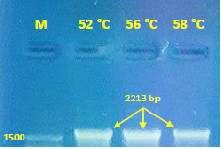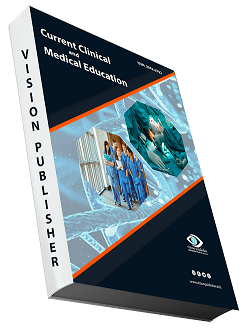Comparative analysis of using CRISPR-1 locus, 16S rRNA and rrnH as identification systems for clinical strains of Salmonella enterica species
Keywords:
CRISPR-1 locus, 16S rRNA, rrnH, Salmonella entericaAbstract
Salmonella enterica species are major global foodborne pathogensthat are divided into six distinct subspecies. Proper identification of Salmonella species is a challenge for many laboratories. In Salmonella, CRISPR loci were found to be conserved in all Salmonella species and also very diverse. Therefore, it could be potentially used as a promising target region for Salmonella identification. Henceforth,we aimed tointroduce a new subtyping genetic system for genotyping someclinical Zoonotic Salmonella isolates using a PCR assay that is targeting the CRISPR-1 region. About total 30 isolates were analysed in this study (human isolates n=10, camel isolates n=10 and poultry isolates n=10). All these isolates were previously identified at the genus and species level following an analysis of DNA sequences of 16S rRNA and rrnH.
At PCR amplification level, the system was able to amplifyall 10 human isolates (33.3%) and 7 camel-isolates (23.3%) 10 chicken isolates (33.3%).
Finally, due to the fact that the tested isolates were previously identified and serotyped by two different systems (16S rRNA and rrnH), this identification and serotyping was also validated by our new CRISPR-1 sequence system. The validation showed non-confirmative results as CRISPR-1 system identified the human and camel isolates as Salmonella enterica sp. enterica serovar Enteritidis and the chicken isolate as Salmonella enterica sp. enterica serovar Anatum. On the other hand, 16S rRNA identified the chicken isolate as Salmonella enterica sp. enterica serovar Typhimurium while the rrnH system identified the camel isolate as Salmonella enterica sp. enterica serovar Indiana. Therefore, these results showed that a definitive identification requires using multiple genomic regions instead of sequencing a one region for bacteria.
Downloads
References
Biswas, A., Staals, R. H. J., Morales, S. E., Fineran, P. C., & Brown, C. M. (2016). CRISPRDetect: a flexible algorithm to define CRISPR arrays. BMC Genomics, 17(1), 1–14.
Ehuwa, O., Jaiswal, A. K., & Jaiswal, S. (2021). Salmonella, food safety and food handling practices. Foods, 10(5), 907.
Fabre, L., Zhang, J., Guigon, G., Le Hello, S., Guibert, V., Accou-Demartin, M., de Romans, S., Lim, C., Roux, C., Passet, V., Diancourt, L., Guibourdenche, M., Issenhuth-Jeanjean, S., Achtman, M., Brisse, S., Sola, C., & Weill, F. X. (2012). Crispr typing and subtyping for improved Laboratory surveillance of Salmonella infections. PLoS ONE, 7(5). https://doi.org/10.1371/journal.pone.0036995
Fitzgerald, C., Collins, M., van Duyne, S., Mikoleit, M., Brown, T., & Fields, P. (2007). Multiplex, bead-based suspension array for molecular determination of common Salmonella serogroups. Journal of Clinical Microbiology, 45(10), 3323–3334.
Gal-Mor, O. (2018). Persistent infection and long-term carriage of typhoidal and nontyphoidal salmonellae. Clinical Microbiology Reviews, 32(1), e00088-18.
Grissa, I., Vergnaud, G., & Pourcel, C. (2007). The CRISPRdb database and tools to display CRISPRs and to generate dictionaries of spacers and repeats. BMC Bioinformatics, 8(1), 1–10.
Heymans, R., Vila, A., van Heerwaarden, C. A. M., Jansen, C. C. C., Castelijn, G. A. A., van der Voort, M., & Biesta-Peters, E. G. (2018). Rapid detection and differentiation of Salmonella species, Salmonella Typhimurium and Salmonella Enteritidis by multiplex quantitative PCR. PloS One, 13(10), e0206316.
Jiang, Z., Anwar, T. M., Peng, X., Biswas, S., Elbediwi, M., Li, Y., Fang, W., & Yue, M. (2021). Prevalence and antimicrobial resistance of Salmonella recovered from pig-borne food products in Henan, China. Food Control, 121, 107535.
Jin, R., Zheng, Y., Yuan, Y., Han, D., Cao, Y., Zhang, Y., Li, C., Xiang, J., Zhang, Z., & Niu, Z. (2022). Robotic-assisted versus video-assisted thoracoscopic lobectomy: short-term results of a randomized clinical trial (RVlob Trial). Annals of Surgery, 275(2), 295–302.
Le Minor, L., & Popoff, M. Y. (1987). Designation of Salmonella enterica sp. nov., nom. rev., as the Type and Only Species of the Genus Salmonella: Request for an Opinion. International Journal of Systematic and Evolutionary Microbiology, 37(4), 465–468.
McQuiston, J. R., Waters, R. J., Dinsmore, B. A., Mikoleit, M. L., & Fields, P. I. (2011). Molecular determination of H antigens of Salmonella by use of a microsphere-based liquid array. Journal of Clinical Microbiology, 49(2), 565–573.
Nethery, M. A., & Barrangou, R. (2019). CRISPR Visualizer: rapid identification and visualization of CRISPR loci via an automated high-throughput processing pipeline. RNA Biology, 16(4), 577–584.
Pan, H., Paudyal, N., Li, X., Fang, W., & Yue, M. (2018). Multiple food-animal-borne route in transmission of antibiotic-resistant Salmonella Newport to humans. Frontiers in Microbiology, 9, 23.
Selle, K., & Barrangou, R. (2015). CRISPR‐Based technologies and the future of food science. Journal of Food Science, 80(11), R2367–R2372.
Wattiau, P., Boland, C., & Bertrand, S. (2011). Methodologies for Salmonella enterica subsp. enterica subtyping: gold standards and alternatives. Applied and Environmental Microbiology, 77(22), 7877–7885.
Westra, E. R., Buckling, A., & Fineran, P. C. (2014). CRISPR–Cas systems: beyond adaptive immunity. Nature Reviews Microbiology, 12(5), 317–326.

Downloads
Published
How to Cite
Issue
Section
License

This work is licensed under a Creative Commons Attribution 4.0 International License.
Current Clinical and Medical Education













